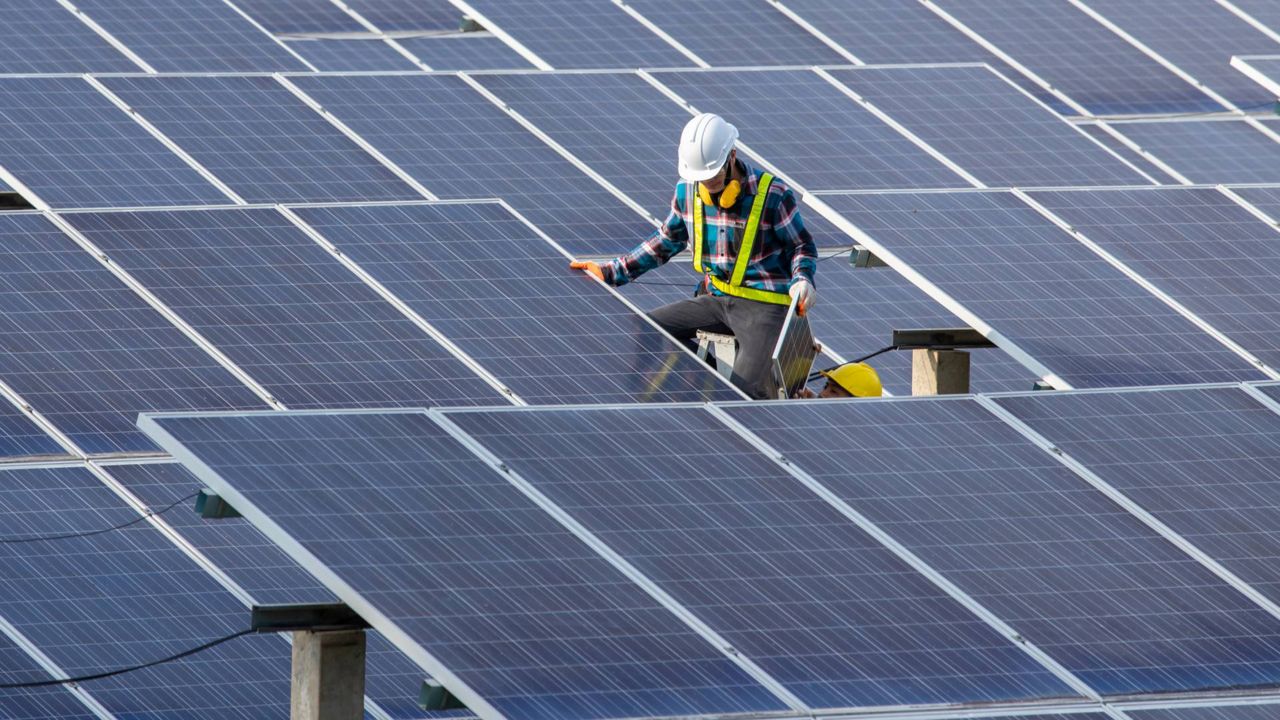LOS ANGELES — The city of Los Angeles could be powered with 100% renewable energy 10 years earlier than initially projected.
That’s the result of the LA100 study that the Department of Water and Power conducted in partnership with the National Renewable Energy Lab.
“Top scientists have looked at our goal to move L.A. to 100% renewable energy. Not only is this doable, but there are literally hundreds of pathways for us to get there,” L.A. Mayor Eric Garcetti said in a webinar announcing the study results Wednesday.
L.A. had targeted 2045 as the date by which it would no longer be powered with fossil fuels, as part of the Green New Deal Mayor Garcetti introduced in 2019. The LA100 study found that the city could achieve that goal by 2035, generating electricity through a combination of wind and solar power that can be stored in batteries, as well as hydrogen fuel cells.
“LA100 is a road map for other cities and states to follow,” said U.S. Secretary of Energy Jennifer Granholm during the webinar, noting that President Biden has laid out the boldest climate agenda in the country’s history.
“The Department of Energy has built the model necessary to help a large city like L.A. see that energy transformation is not just possible but preferable,” Granholm said. ”There is no place in America that we can’t help chart their path forward. If we can do this in L.A., we can do it anywhere.”
LA100 is the result of several City Council motions that directed LADWP to determine the technical feasibility and finances to achieve an entirely renewable electrical grid. It’s the first study of its kind to look at a power system as large as L.A.’s and to develop a roadmap for renewables that is also resilient during natural disasters like wildfires and earthquakes — while considering air quality, health impacts, job creation, affordability, and environmental justice.
In the works for three years, LA100 was conducted by the NREL in partnership with LADWP using input from an advisory group representing 35 organizations throughout the region and local community groups. In determining its findings, the NREL ran more than 100 million simulations that modeled the solar potential of every property in the city, the electricity usage of 7 million buildings, and the electricity distribution circuits that reach nearly every structure, among other things.
“Most of the 100% renewable energy is met on a year-to-year basis with wind, solar, and batteries. That gets you 70 to 90% of the way there,” said Jacquelin Cochran, manager of the grid systems group for the NREL. “After that is the question of how you meet demand for electricity when you have a really bad week of renewable energy, so your batteries don't get recharged, it’s cloudy, or it’s a low period for wind across the west.”
Beyond that, she added, “we want to be ready for when things go wrong,” like power transmission lines going down because of wildfires.
“One of the findings of this study is the high value of having something in the city that you can turn on and run for days,” she said.
This includes urban hydrogen production that could be combusted in a high-efficiency turbine or fuel cell. It’s the model involving hydrogen that allows L.A. to achieve 100% renewable energy by 2035 — a goal few people thought was even possible a decade ago. In 2006, LADWP was at 5% renewables.
“Back then, people said you can’t get to 10%, and here we are at 34%,” said Reiko Kerr, LADWP’s senior assistant general manager of power systems engineering, planning, and technical services. “We are right where we said we would be.”
Before Garcetti announced L.A.’s Green New Deal in April 2019, LADWP was working to meet the goals of SB100, the bill former California Gov. Jerry Brown signed into law in 2018, mandating that all of the state’s electricity be fossil-free by 2045. One of SB100’s targets was 60% renewables by 2030, but the Green New Deal accelerated the target to 55% renewables by 2025, 80% by 2036, and 100% by 2045.
The LA100 study accelerates those timelines once again.
“Every year we face new and daunting threats: record-breaking heat waves that literally melt our power cables, wildfires. These forces threaten all of us. We’re not here just because we want good jobs,” Mayor Garcetti said, adding that a quarter of the jobs created in the last decade came from clean energy jobs. “We’re not here because we want to have cleaner air or want to see more sustainable energy. We’re here because we need to save our planet.”



